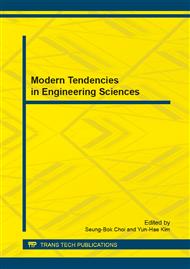[1]
Anil, B. J., & Karol, L. P. (2006). A Model Of Knowledge Processes In A Manufacturing Company. Journal Of Manufacturing Technology Management Vol 17(3) , pg315-331.
Google Scholar
[2]
Barbati, M., Bruno, G., & Genovese, A. (2012). Applications Of Agend-Based Models For Optimization Problems: A Literature Review. Expert Systems With APplication, Vol 39 , 6020-6028.
DOI: 10.1016/j.eswa.2011.12.015
Google Scholar
[3]
Braha, D., & Shmilovici, A. (2002). Data Mining For Improving A Cleaning Process In The Semiconductor Industry. Semiconductor Manufacturing. Vol 15(1) , pg91-101.
DOI: 10.1109/66.983448
Google Scholar
[4]
Bransford, J., & Stein, B. (1993). The IDEAL Problem Solver (2nd ed). New York: Freeman.
Google Scholar
[5]
Eisentraut, R. (1999). Styles of problem solving and their influence on the design process. Design Studies Vol 20 No 5 , Pg431-437.
DOI: 10.1016/s0142-694x(99)00016-2
Google Scholar
[6]
Good, R., & Smith, M. (1987). How Do We Make Students Better Problem Solvers? The Science Teacher 54(4) , pg31-36.
Google Scholar
[7]
Gray, P. H. (2001). A Problem-Solving Perspective. Decision Support System Vol. 31 , 87-102.
Google Scholar
[8]
Guffey, M. E. (1996). Business Communication: Process & Product. Cincinnati: South-Wester College Publishing.
Google Scholar
[9]
Howard, M. (2002). Complex Problem Solving In A Workplace Setting. International Journal Of Education Research, Vol. 37 , 67-84.
Google Scholar
[10]
Huber, G. (1991). Organizational Learning: The Contributing Processes And The Literatures. Organization Science 2.
Google Scholar
[11]
Kumar, L. (2010). A Conceptual Framework Mapping The Application Of The Information Search Strategies To Well And Ill-Structured Problem Solving. Computers & Education Vol. 55 , pg513-516.
DOI: 10.1016/j.compedu.2010.02.014
Google Scholar
[12]
Lewis, T., Petrina, S., & Hill, A. (1997). Problem Posing: Adding A Creative Increament To Technological Problem Solving. Journal Of Industrial Education. Vol 36(1) , pg5-35.
Google Scholar
[13]
Mayer, R. (1999). Multimedia Aids To Problem-Solving Transfer. International Journal Of Educational Research 31. , pg611-623.
Google Scholar
[14]
Mayer, R. (1992). Thinking Problem Solving Cognition. W. H Freeman and Company.
Google Scholar
[15]
Nelson, R. (1982). The Role Of Knowledge In R&D Efficiency. Quarterly Journal Of Economics, Vol. 97 (3) , pg453-470.
Google Scholar
[16]
Newell, A., & Simon, H. (1972). Human Problem Solving. Englewood Cliffs, NJ: Prentice-Hall.
Google Scholar
[17]
NSTA. (1985). Science Technology Society: Science Education For The 1980's. Washington DC: pg46-49.
Google Scholar
[18]
Paulo, V. A. (1987). On The Concepts Of Problem And Problem-Solving Method. Decision Support Systems. Vol 3(2) , pg133-139.
Google Scholar
[19]
Powers, M. H. (1984). A Computer Assisted Problem SOlving Method For Beginning Chemistry Students. The Journal Of Computers In Mathematics & Science Teaching 4(1) , Pg13-19.
Google Scholar
[20]
Schoennauer, A. W., Chicago, N. -H., & JT, D. (1982). Problem Finding and Problem Solving. Journal of Creative Behavior , pg97-111.
Google Scholar
[21]
Schooler, J., Oblsson, S., & Brooks, K. (1993). Though Beyond Words: When language Overshadows Insight. Journal Of Experimental Psychology , 166-183.
DOI: 10.1037/0096-3445.122.2.166
Google Scholar
[22]
Schooler, J., Ohlsson, S., & Brooks, K. (1993). Thoughts Beyond Words - When Language Overshadows Insight. Journal Of Experimental Psychology, General 122 , Pg166-183.
DOI: 10.1037/0096-3445.122.2.166
Google Scholar
[23]
Tanner, C. (2002). Clinical Education. Journal Of Nursing Education Version 41(2) , pg51-52.
Google Scholar
[24]
Veloso, P. A. (1987). Decision Support System, Vol. 3, Issue 2 , 133-139.
Google Scholar
[25]
Welch, M. (1999). Analyzing The Tacit Strategies Of Novice Designers. Research In Science & Technical Education, Vol. 17(1) , Pg19-34.
DOI: 10.1080/0263514990170102
Google Scholar
[26]
William, D. J., & Noves, J. M. (2007). Effect of Experience And Mode Of Presentation On Problem Solving. Computers in Human Behavior 23 (2007) , pg258–274.
Google Scholar
[27]
Wu, T. -F., Custer, R. L., & Dyrenfurth, M. J. (1996). Technological & Personal Problem Solving Styles: Is there A Difference? Journal Of Technology Education, Vol. 7 (2). Spring.
DOI: 10.21061/jte.v7i2.a.5
Google Scholar
[28]
Zhang, J. S. (2010). Research on developing environmental protection industry. Procedia Environmental Sciences 2 , pg132. 6-1334.
Google Scholar


